If you’re looking to master light-based computing, I recommend exploring the top eight photonic processor textbooks that offer in-depth theories, equations, and recent breakthroughs like integrated photonics and nonlinear optics. These books are designed for readers with strong technical backgrounds and cover real-world applications and emerging technologies. They include detailed derivations and case studies to enhance your understanding. Keep going, and you’ll uncover everything you need to excel in this cutting-edge field.
Key Takeaways
- Choose textbooks with detailed derivations, equations, and practical explanations for in-depth understanding of photonic processes.
- Prioritize books covering recent breakthroughs like integrated circuits, quantum photonics, and advanced modulation techniques.
- Consider physical quality and condition, ensuring copies are well-maintained for durability and long-term study.
- Opt for resources that balance theoretical rigor with real-world applications, including case studies and industry relevance.
- Select books with supplementary materials such as exercises, diagrams, and references to support advanced mastery of light-based computing.
Photonics: Optical Electronics in Modern Communications
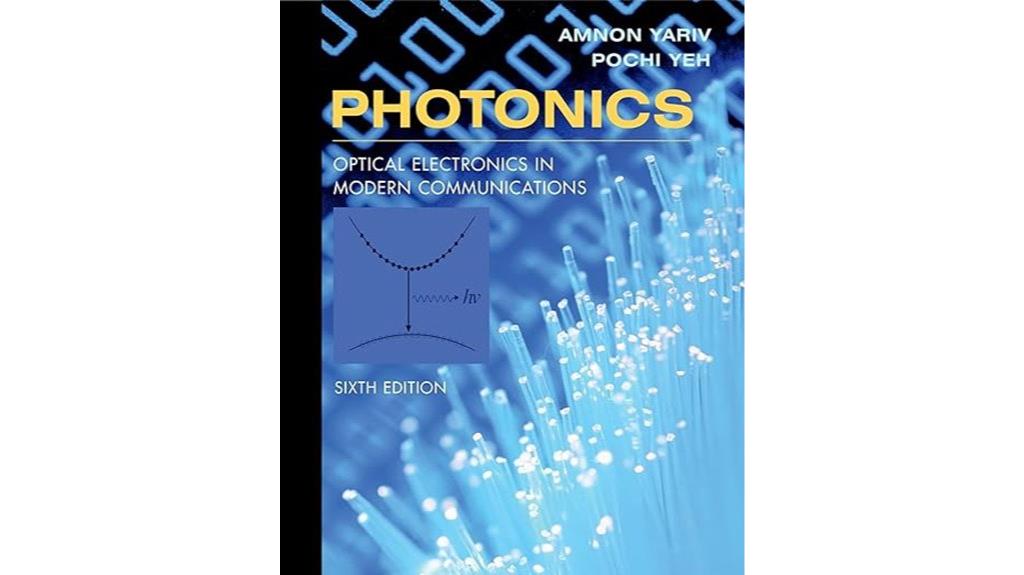
Are you a graduate student seeking a solid foundation in photonics with clear, detailed theoretical explanations? “Photonics: Optical Electronics in Modern Communications” offers thorough coverage of electromagnetic fields, guided waves, lasers, fiber optics, and nonlinear optics. Its step-by-step derivations help you understand complex concepts, making it excellent for independent study. The author’s mentor-like style clarifies challenging topics, especially in laser theory and optical resonators. However, some sections, like semiconductor devices, are outdated. The physical quality can be poor, but the book remains valuable for foundational knowledge. Use it as a supplement alongside more current references for advanced research.
Best For: graduate students seeking a comprehensive, clear, and detailed theoretical foundation in photonics for independent study and moderate coursework.
Pros:
- Clear, logical presentation with a mentor-like explanatory style.
- Thorough theoretical derivations, especially in optics and laser theory.
- Wide coverage of fundamental photonics topics suitable for foundational learning.
Cons:
- Some sections, especially on semiconductor devices, are outdated or lack recent advancements.
- Physical quality issues, including poor packaging and potential damage upon receipt.
- Not ideal as a primary reference due to typographical errors and limited depth in advanced topics.
Nonlinear Optics

If you’re a student or researcher with a foundational understanding of photonics, the “Photonic Processor Textbooks” on Nonlinear Optics stand out as essential resources. These books, especially “Nonlinear Optics” and Y.R. Shen’s work, offer extensive coverage, clear explanations, and helpful illustrations. They’re praised for their readability and solid content, making complex concepts accessible. While some edges may be bruised, the physical quality is generally good. These texts are perfect for coursework, research, and understanding nonlinear phenomena. They align with SI units and are frequently used, making them invaluable for mastering light-based computing and expanding your photonics knowledge.
Best For: students and researchers with a foundational understanding of photonics seeking comprehensive, clear, and well-illustrated resources on nonlinear optics.
Pros:
- Extensive coverage with detailed explanations and helpful diagrams
- Highly readable and suitable for beginners in nonlinear optics
- Well-regarded in the academic community and aligned with SI units
Cons:
- Some physical copies may have bruised edges due to handling or shipping
- Certain complex concepts could benefit from further expansion
- Physical condition of the books, while generally good, may vary slightly
Optical Electronics in Modern Communications

For students and engineers seeking a solid foundation in optical electronics within modern communications, the “Photonic Processor Textbooks” offers a thorough overview that balances mathematical rigor with engaging explanations. The book covers optics, photonics, and fiber optic fundamentals, making complex topics accessible. Its figures and end-of-chapter problems are highly praised, and Yariv’s clear writing style enhances understanding. While older editions remain a cost-effective choice, some reviews note minimal updates across editions, with inconsistent notation and limited pedagogical improvements. Overall, it’s a valuable resource, especially for optical graduates and engineers aiming to deepen their knowledge of light-based communication systems.
Best For: optical engineering students and professionals seeking a comprehensive, mathematically rigorous overview of modern optical communication systems.
Pros:
- Provides a thorough coverage of optics, photonics, and fiber optics fundamentals suitable for deep learning.
- Features high-quality figures and well-crafted end-of-chapter problems that enhance understanding.
- Yariv’s clear and engaging writing style makes complex concepts more accessible.
Cons:
- Many editions contain minimal updates, leading to concerns about outdated notation and limited pedagogical improvements.
- Inconsistent notation and abrupt jumps between concepts can hinder the learning experience.
- Older editions are more cost-effective, but newer editions do not offer significant additional content or clarity.
Elements of Photogrammetry with Application in GIS, Fourth Edition

Elements of Photogrammetry with Application in GIS, Fourth Edition stands out as an essential resource for students and professionals seeking a clear, accessible introduction to photogrammetry concepts. This book is in excellent condition—used but like new, with no signs of wear—and offers improved, simplified explanations that make complex topics easier to grasp. Its concise content is highly practical for studying photogrammetry issues and understanding GIS applications. Despite some poor binding quality, the overall quality remains good, and it’s highly recommended for anyone needing a reliable, straightforward reference. This edition truly enhances learning with its clarity and user-friendly approach.
Best For: students and professionals seeking a clear, practical introduction to photogrammetry concepts and GIS applications.
Pros:
- Simplified explanations enhance understanding of complex topics
- Compact and improved content makes study more efficient
- Excellent condition with no signs of wear, ensuring durability and usability
Cons:
- Binding quality is poor, which may affect long-term durability
- Some users might find the concise content too brief for in-depth study
- Slightly limited in scope compared to more comprehensive texts
Diffraction, Fourier Optics and Imaging
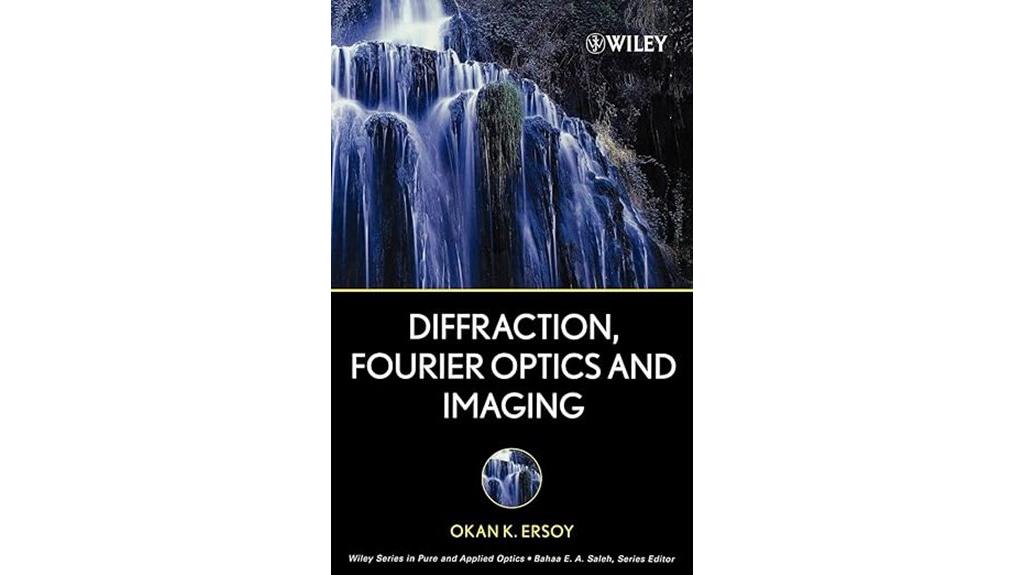
Are you seeking a quick reference to core concepts in diffraction, Fourier optics, and imaging? This topic covers fundamental wave phenomena, the role of Fourier analysis in optical systems, and how images form and process. While the material offers valuable insights, it contains numerous errors, such as typos and incorrect references, making it unreliable as a primary source. It’s better suited for brief reviews or quick consultations, but you should verify critical details elsewhere. Despite its flaws, understanding these principles is essential for mastering light-based computing, so use this resource cautiously and supplement it with more authoritative texts.
Best For: quick concept reviews and brief consultations in diffraction, Fourier optics, and imaging for students or professionals needing a rapid overview.
Pros:
- Offers a broad overview of core optical concepts quickly
- Useful for quick reference and concept refreshers
- Highlights the importance of understanding diffraction and Fourier analysis in optics
Cons:
- Contains numerous typos, editorial errors, and incorrect references
- Not reliable as an authoritative or in-depth resource
- Requires verification of critical details against more accurate sources
Detecting & Classifying Low Probability of Intercept Radar
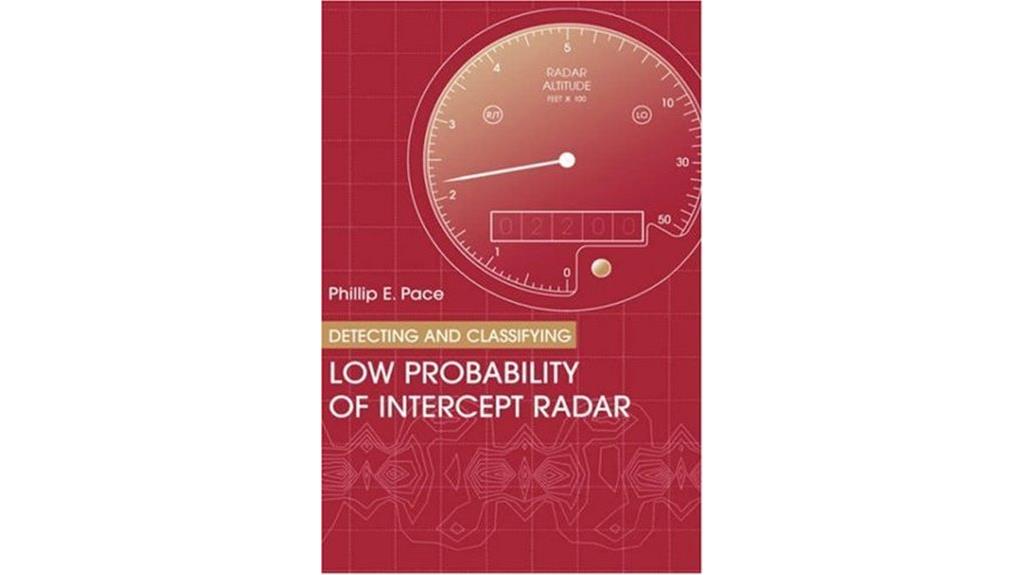
If you’re seeking a clear and authoritative resource on modern radar detection, “Detecting & Classifying Low Probability of Intercept Radar” stands out. This book by Philip E. Pace dives into advanced radar tech, especially LPI systems that operate at surprisingly low power levels—around 1W—yet match traditional radars in detection range. It explains radar phenomena with accessible mathematics, making complex concepts understandable. The book emphasizes how LPI radars are strategically significant, offering effective detection with minimal power. Overall, it’s an invaluable guide for grasping how modern radars evade interception while maintaining performance, a pivotal skill in contemporary electronic warfare.
Best For: professionals and scholars seeking an in-depth, authoritative understanding of modern low probability of intercept radar systems and their strategic applications.
Pros:
- Provides comprehensive explanations supported by precise mathematics, making complex radar phenomena accessible.
- Highlights the strategic importance of low-power LPI radars, demonstrating their effectiveness in electronic warfare.
- Authored by Philip E. Pace, ensuring reliable, clear, and authoritative insights into radar technology.
Cons:
- May be technically dense for readers without a background in radar or electronic warfare concepts.
- Focuses primarily on advanced radar systems, which might be less suitable for beginners.
- The hardcover format might be less convenient for quick reference or field use.
Handbook of Optical and Laser Scanning
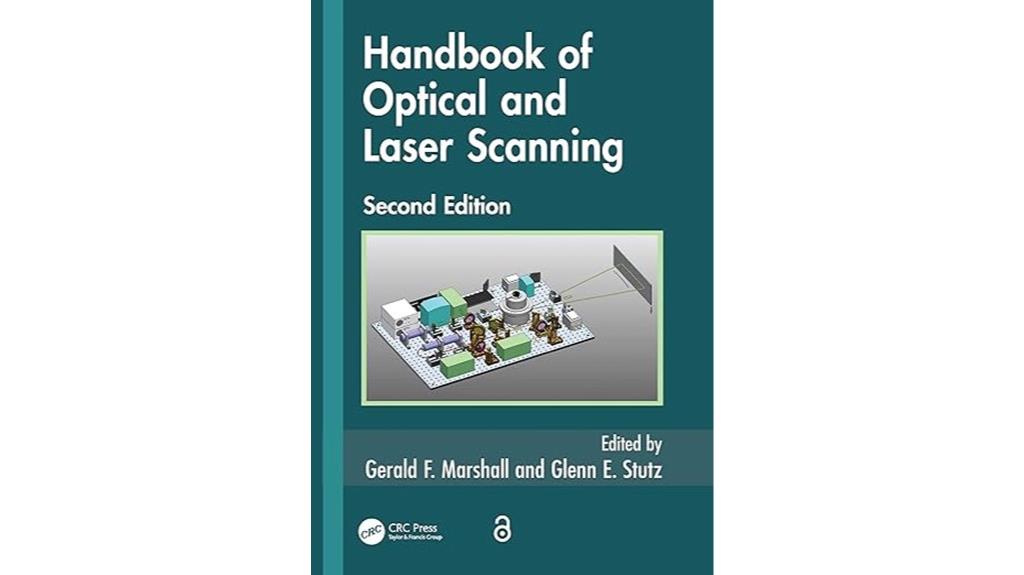
The “Handbook of Optical and Laser Scanning” stands out as an essential resource for researchers and engineers working in the field of optical scanning technologies. I appreciate its thorough coverage of scanning principles and applications, making complex concepts accessible. However, I must note the typesetting issues, especially with Greek symbols like π and λ, which are often misrendered in formulas. Despite these formatting flaws, I’d rate it five stars for its valuable content. Correct typesetting is indispensable in scientific texts, as it ensures clarity and precision—especially when dealing with mathematical symbols and formulas critical to understanding optical and laser scanning systems.
Best For: researchers and engineers seeking an in-depth resource on optical scanning principles and applications despite minor formatting issues.
Pros:
- Comprehensive coverage of optical and laser scanning topics
- Accessible explanations of complex concepts
- Valuable for both academic and professional use
Cons:
- Typesetting errors in formulas, especially Greek symbols like π and λ
- Formatting issues can hinder readability and understanding
- Slightly outdated presentation due to typesetting flaws
Machine Vision Algorithms and Applications
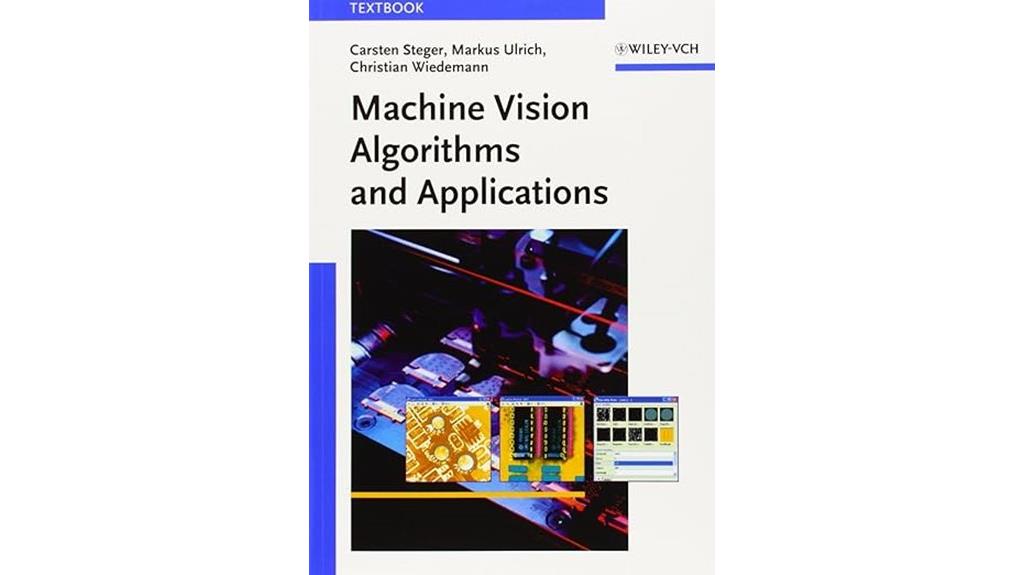
For readers with a solid technical background seeking a deeper understanding of current research in machine vision algorithms, “Photonic Processor Textbooks” offers valuable insights. It explores advanced topics like image segmentation, morphology, and edge extraction, emphasizing mathematical rigor. While it doesn’t provide implementation details, it helps identify key algorithms, their strengths, and weaknesses, especially in real-world applications. The book complements foundational texts by focusing on emerging research issues and practical aspects such as sensors and lighting. Although some chapters may lack polish, it’s a resource for those aiming to deepen their theoretical knowledge and stay current with cutting-edge machine vision developments.
Best For: readers with a solid technical background seeking to deepen their understanding of current research and advanced concepts in machine vision algorithms.
Pros:
- Provides detailed mathematical explanations and derivations for complex topics like image segmentation and edge extraction.
- Focuses on current research issues, offering insights into emerging trends and challenges in machine vision.
- Emphasizes real-world applications and practical considerations such as sensors and lighting, bridging theory and practice.
Cons:
- Some chapters may contain contradictions and lack polish, reflecting a less rigorous editing process.
- Does not include implementation details or programming guidance, limiting practical coding application.
- Assumes prior knowledge, making it less accessible for beginners without a strong technical background.
Factors to Consider When Choosing Photonic Processor Textbooks
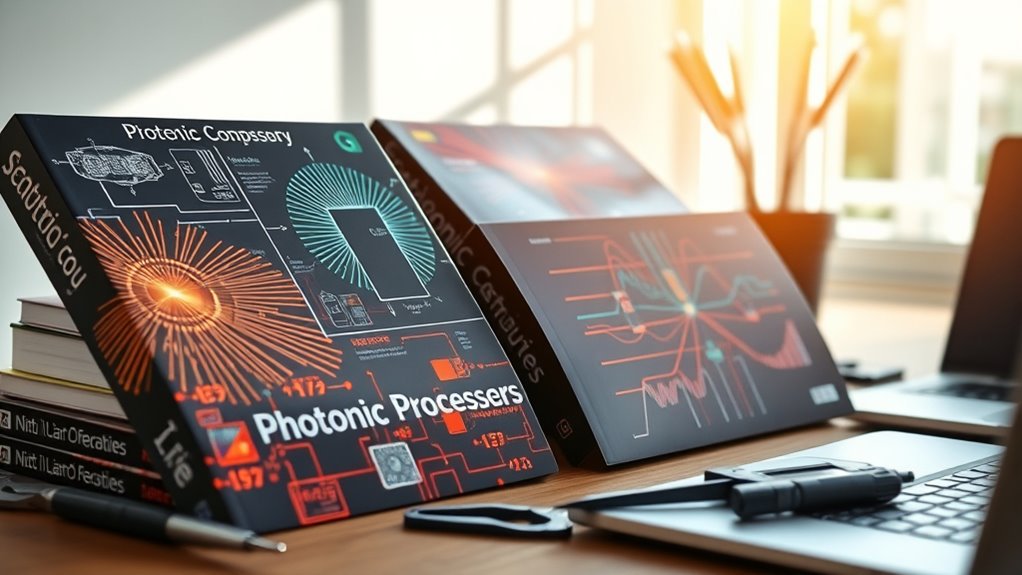
When selecting a photonic processor textbook, I focus on several key factors to guarantee it meets my needs. I consider how much technical detail it covers, whether the content is up-to-date, and if the pedagogical approach matches my learning style. Additionally, I look at its practical application focus and the quality of the physical book to make an informed choice.
Depth of Technical Detail
How do you determine if a photonic processor textbook offers the right level of technical detail? First, look for detailed derivations and equations that explain complex photonic processes—these are vital for grasping advanced concepts. Check if the book balances mathematical rigor with practical explanations, helping you understand device operation without overwhelming you. Consider whether it covers advanced topics like nonlinear optics, waveguide coupling, and semiconductor lasers, which indicate a deep technical level. Also, see if it includes supplementary appendices or references that support in-depth study of mathematical tools used in photonics. Finally, confirm the material matches your current knowledge, providing enough detail to challenge you without being excessively complex or overly simplified.
Updated Content Availability
Choosing a photonic processor textbook that keeps up with the latest advancements requires careful consideration of its content updates. I look for books that cover recent breakthroughs, like integrated photonic circuits and novel modulation techniques, guaranteeing I stay current. Checking if the edition has been recently updated or if it references emerging technologies such as quantum photonics or advanced materials helps me gauge its relevance. I also verify whether it includes recent applications in optical computing, neural networks, and high-speed data processing, which reflect real-world uses. Additionally, I prefer textbooks that cite recent research papers and feature new case studies, indicating they incorporate the latest scientific developments. Ensuring the publication date aligns with industry trends ensures I access the most current insights in this rapidly evolving field.
Pedagogical Approach Alignment
Selecting a photonic processor textbook that aligns with my learning style is crucial for making the most of the material. I look for a teaching approach that matches how I best absorb information—whether through detailed theoretical derivations, practical examples, or visual explanations. A good book balances mathematical rigor with clear, conceptual insights, helping me grasp complex photonic processes. I also prefer resources that build foundational knowledge gradually, so I can layer new concepts effectively. Pedagogical features like exercises, summaries, and diagrams are indispensable, reinforcing my understanding. Finally, I ensure the approach aligns with my specific focus within photonics, whether it’s device physics, integrated optics, or system applications, to make my learning targeted and efficient.
Practical Application Focus
Ever wondered what makes a photonic processor textbook truly useful for real-world applications? It’s essential that the book emphasizes practical implementation details and showcases how photonic processors are used in industry. Look for resources containing case studies, real-world examples, and problem sets that mirror actual design and deployment scenarios. Prioritize textbooks covering current technologies like integrated photonic circuits, optical switching, and signal processing techniques relevant to modern applications. A good book should bridge theory with hands-on engineering practices, helping you translate concepts into functional systems. Additionally, it’s beneficial if the material discusses limitations, challenges, and future trends, preparing you for real-world problem-solving and technological evolution. This practical focus guarantees you gain applicable skills alongside foundational knowledge.
Physical Book Quality
When evaluating photonic processor textbooks, paying attention to the physical quality of the book itself can make a significant difference in your long-term learning experience. Check for tears, markings, or creases that could compromise durability. The binding quality is vital—poor bindings may cause pages to fall out over time, even if the book looks fine. When buying used, aim for copies in like-new or very good condition to guarantee longevity. Also, examine the packaging during shipping; inadequate packaging can lead to damage like bent corners or splitting covers. Look for signs of excessive wear or fading, which can make reading difficult and reduce the book’s value. Prioritizing physical condition helps you invest in a durable resource that remains reliable through your studies.
Frequently Asked Questions
Which Photonic Processor Textbooks Are Most Accessible for Beginners?
You’re wondering which photonic processor textbooks are most accessible for beginners. I recommend starting with “Photonic Integrated Circuits” by Marpaung et al., as it explains fundamental concepts clearly. Another great choice is “Introduction to Photonic Computing” by Shih, which simplifies complex ideas. These books strike a good balance between technical depth and understandable language, making them perfect for newcomers enthusiastic to learn about light-based computing.
Are There Any Online Resources Complementing These Textbooks?
You’re curious about online resources that complement photonic processor textbooks. I’ve found that websites like IEEE Xplore and ResearchGate offer valuable articles and papers to deepen your understanding. Additionally, platforms like Coursera and edX have courses on photonics and light-based computing. These resources are great for visual explanations, tutorials, and staying updated on the latest advancements, making your learning experience more exhaustive and engaging.
How Current Are These Textbooks Regarding Recent Photonic Technology Advances?
You might worry that textbooks are outdated given rapid tech advances, but I’ve found many are quite current. These books often include recent breakthroughs up to their publication date, and authors update editions regularly. While some details may lag behind the fastest innovations, they still provide a solid foundation. I recommend supplementing with recent journal articles and online resources for the latest developments in photonic technology.
Do These Books Cover Practical Implementation of Light-Based Computing Systems?
You’re asking if these books cover practical implementation of light-based computing systems. I find that most of them focus on foundational theory and design principles, but some do include real-world examples and case studies. If you’re seeking hands-on guidance, look for titles that emphasize experimental setups and system integration. I recommend checking the table of contents to ascertain they address practical aspects alongside theoretical concepts.
Which Textbooks Include Hands-On Laboratory Exercises or Case Studies?
Think of these textbooks as your guiding map through a dark forest of photonics. Many include hands-on lab exercises or case studies, helping you navigate real-world applications. I found books like “Photonic Integrated Circuits” and “Introduction to Photonics” particularly practical, offering detailed experiments and case discussions. They’re perfect if you want to go beyond theory and truly understand how to implement light-based computing systems yourself.
Conclusion
If you’re enthusiastic to excel in light-based learning, these textbooks truly tackle techniques, tools, and theories to transform your understanding. Explore dazzling details, discover dynamic designs, and develop your domain with dedication. Remember, mastering photonics requires patience, practice, and passion. So, pick a book, push past pitfalls, and propel your progress forward. With perseverance and the right resources, you’ll light the way to a luminous future in photonic processing.










